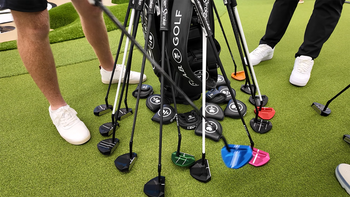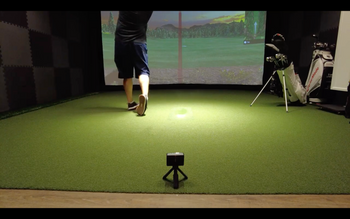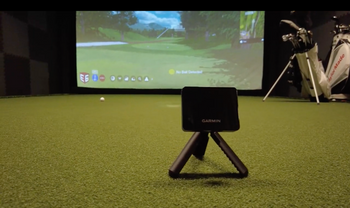So here's the deal - Garmin just dropped something that's got everyone in the golf world buzzing. Their new Approach R50 might've just changed the whole launch monitor game, and you're probably wondering if it's worth your hard-earned cash.
You know how the pros always use those crazy expensive Trackman units? Well, the R50 is making people question whether Trackman's still king of the hill. That's a pretty bold claim, considering Trackman's been the gold standard forever.
Let me break it down for you. The tour guys typically roll with either Foresight's GCQuad (or the even fancier QuadMAX) or they stick with Trackman. These things are basically the Ferraris of shot tracking - they'll tell you everything from your spin rate to what you had for breakfast.
Now everyone's asking if Garmin's new toy belongs in that same conversation. Hell, some folks think it might even be better.
I've already gone deep on comparing Foresight's top products against Trackman (spoiler alert: Foresight takes the crown in my book). But let's be real - if the R50 wants to play in the big leagues, it's gotta prove itself against Trackman first. That's like beating the defending champ before you can challenge for the title.
The early buzz around the R50 is seriously impressive. Guys who've gotten their hands on it can't stop raving about how it performs. And these aren't just weekend hackers - we're talking serious players who know their tech.
Think about it - when was the last time a new launch monitor got people this excited? Usually, these things come out with minor upgrades, and everyone yawns. But Garmin's bringing something different to the table, and it's making waves in ways nobody expected.
Table of Contents
Key Features
Price Difference: The most striking difference is the massive price gap between these two launch monitors. The Garmin Approach R50 retails for $4,999.99, while the TrackMan 4 starts at $21,995 - nearly a $17,000 difference. This makes the R50 significantly more accessible to amateur golfers and home users who want professional-grade data without the premium price tag.
Ease of Setup and Use: The Garmin R50 offers unparalleled simplicity with its built-in 10" touchscreen display that eliminates the need for additional devices. You can get all the shot information directly on the device without requiring smartphones, computers, or internet connections. In contrast, TrackMan requires a smartphone, computer, or iPad plus internet connectivity, and needs precise alignment that takes several minutes to dial in properly.
Built-in Simulator Capability: The R50 is the world's first portable launch monitor with a ready-to-go, built-in simulator featuring Home Tee Hero with over 43,000 preloaded golf courses. This allows immediate simulator play without additional software or devices. TrackMan requires third-party simulator software and a robust gaming computer to run simulation programs.
Garmin R50 Launch Monitor
Garmin R50 revolutionizes practice with the world’s first all-in-one portable launch monitor and simulator.
Discovering What Sets the R50 Apart from the Competition
You've probably heard the buzz about Garmin's R50 launch monitor, and let me tell you – this thing is unlike anything else you can buy right now. Picture this: you're setting up a launch monitor that actually has simulator golf built right into it. No extra computer needed, no complicated software to install. Just the R50 itself.
Think about your current setup or what you've seen at other people's houses. Most launch monitors need a whole computer system, special software licenses, and a bunch of cables running everywhere. The R50? You can literally plug it straight into your TV or projector and start playing Pebble Beach. That's it. Nobody else makes anything like this.
What really catches your eye first is that massive 10-inch color screen. While other launch monitors show you numbers on your phone or require you to look at a separate monitor, this beast displays everything right there – your ball speed, launch angle, spin rate, the whole nine yards. You can even play full simulator rounds on that screen if you don't feel like hooking it up to anything bigger.
Now, Trackman's been the gold standard in launch monitors for years, and they basically invented the category. They deserve credit for that. But they're playing a completely different game than what Garmin's doing here. It's like comparing a traditional driver to one of those new adjustable ones – both hit the ball, but one's bringing way more to the table.
Here's why this matters for your game: when you're practicing, you want instant feedback without fussing with technology. The R50 tracks both your ball and club data using its three high-speed cameras and radar system. You'll see exactly why that slice happened – was it your face angle at impact or your swing path? The data pops up immediately on that big screen, so you can make adjustments on the next swing.
The simulator golf feature isn't just a gimmick either. You're getting access to over 43,000 courses worldwide. So when it's pouring outside or you've got 30 minutes after work, you can still work on your game. The graphics won't blow you away like some $50,000 simulators, but they're more than good enough to help you practice course management and different shot scenarios.
For accuracy, you're looking at measurements within 1% of those super expensive tour-level systems. Your carry distance, ball speed, and spin rates are all captured precisely. The club data – like your attack angle and club path – helps you understand why you're hitting certain shots. If you're fighting a hook, you'll quickly see if you're swinging too far from the inside.
What I really like is how portable this thing is compared to other options. At about 15 pounds, you can actually move it from your garage to the range or even take it to a buddy's place. Try doing that with a Trackman or most other professional monitors – you'd need a truck and an engineering degree to set them back up.
The setup process takes maybe 10 minutes your first time. You don't need to be tech-savvy at all. Position it behind your hitting area, plug it in, and you're basically ready to go. The built-in alignment aids help you get it positioned correctly, and the system walks you through everything on that touchscreen.
Here's where it gets interesting for improving your scores: the R50 stores all your session data, so you can track your progress over time. Let's say you've been working on increasing your driver swing speed. You can check your average from last month versus this month and see if those gym sessions are paying off. It even recommends drills based on your tendencies.
The shot dispersion patterns are eye-opening, too. You might think you hit your 7-iron 150 yards, but the R50 will show you that your average is actually 142 with a 15-yard dispersion. That kind of reality check can save you several strokes per round just from better club selection.
Battery life runs about 4 hours per charge, which is enough for a solid practice session. If you're using it plugged in at home, that's obviously not an issue. The whole unit feels really solid – this isn't some flimsy plastic gadget that'll break if you look at it wrong.
Now, let's be real about limitations. At around $5,000, this isn't pocket change. You could buy a pretty nice set of irons for that money. The R50 also needs about 8 feet of ball flight to get accurate readings, so super tight spaces won't work. And while the simulator graphics are good, dedicated golf simulator guys might find them a bit basic compared to high-end systems.
The weather can affect it too. Strong winds at the range might throw off some readings, and you definitely don't want to use it in the rain. It's weather-resistant but not waterproof. Also, while the touchscreen is great, it can be tough to see in really bright sunlight.
For lefties out there, you'll be happy to know it automatically detects which side you're hitting from. No manual switching needed. The system also handles different ball types well, whether you're hitting range balls or your premium Pro V1s.
The bottom line? If you're serious about improving and have the budget, the R50 offers something no other monitor does. You're getting tour-level data accuracy, built-in simulator golf, and the simplest setup imaginable. It's perfect for the golfer who wants professional feedback without the professional complexity. Your practice sessions will never be the same, and your scores will show it.
TrackMan Golf Launch Monitor
TrackMan 4 is the elite launch monitor, trusted by pros for its dual radar tech, unmatched accuracy, and advanced golf simulation.
How Trackman Revolutionized Golf Launch Monitors
You know that buddy who always knows exactly how far he hit his 7-iron? That's what having a Trackman feels like. Back in 2004, these guys basically flipped the golf world upside down by being the first to use Doppler radar-yeah, the same tech cops use to catch speeders-to track your golf ball and club in 3D.
Here's the deal: before Trackman showed up, launch monitors were pretty basic. But this thing? It watches your entire shot from the moment you swing through impact until your ball lands. You're getting data on stuff like smash factor (basically how efficiently you're transferring energy to the ball) and dynamic loft (the actual loft of your club at impact, not just what's stamped on it).
The tour pros caught on quick. In 2006, the PGA Tour started using Trackman, and suddenly these guys could nail their distances like never before. They're out there fine-tuning their games with precision that would've seemed like science fiction just a few years earlier.
What really changed the game was how Trackman proved what actually makes the ball fly the way it does. Turns out, a lot of what instructors were teaching about ball flight was wrong. Your ball starts mostly where your clubface is pointing at impact, not your swing path like everyone used to think. This completely changed how coaches teach and how fitters match you with the right clubs.
So why should you care? Because this technology that tour pros use is now available to help your game, too. You'll finally understand why you're slicing that driver (spoiler: it's probably your face angle) and get real numbers on your distances instead of guessing. Sure, it's an investment - we're talking serious cash here - but if you're tired of wondering why your shots do what they do, this gives you the answers.
The downside? Besides the price tag that'll make your spouse raise an eyebrow, you might discover you don't hit it as far as you thought. But hey, knowing your real numbers beats telling your buddies you "crushed it 280" when it actually went 240. At least now you'll know exactly how to improve.

Are These Cutting-Edge Devices Tailored for Different Golfers?
You know how launch monitors used to be this exclusive club thing? When Trackman first hit the scene, it was groundbreaking tech that basically revolutionized how we understand ball flight. But here's the thing – back then, if you wanted that data, you either had to be a tour pro or have tour pro money.
These days? The game's completely changed. You've got options at every price point, and honestly, most of them are pretty solid. The accuracy gap between the expensive stuff and the mid-range gear has shrunk dramatically.
Which brings us to why the Garmin R50 and Trackman aren't really competing for your attention anymore. They're playing different games entirely.
Think about it this way: Trackman's still chasing that last 1% of accuracy that tour players and their coaches obsess over. But for you and me? We're looking for something different. We want accuracy, sure, but we also want to actually enjoy using the thing.
That's where the R50 shines. You're getting tour-level accuracy (seriously, it's that good), but wrapped up in a package that's actually fun to use. Hook it up to your TV, and boom – you've got a home simulator. The built-in screen means you can take it to the range without lugging around an iPad. It's convenience meets performance.
The old days of "either you can afford good data or you can't" are over. Now it's about matching the right tool to what you actually want to do. Pro is trying to dial in spin rates to the tenth of a degree? Trackman's your answer. Want to improve your game while also having buddies over for simulator nights? The R50's got you covered.
Bottom line: Today's launch monitor market isn't about who has the deepest pockets anymore. It's about finding the device that fits how you actually want to practice and play. And for most of us weekend warriors, that means something that delivers the goods without making practice feel like work.
Garmin Approach R50 vs Trackman – Why the Price Gap Matters
You're looking at two completely different animals when comparing launch monitor prices here. The R50 will set you back five grand while Trackman's floor model runs a jaw-dropping twenty-two thousand bucks. Let me put that in perspective - that's a seventeen-thousand-dollar gap. You could buy three brand new sets of clubs and still have money left over for a golf trip to Scotland.
So what's the deal with these wildly different price tags? Trackman basically invented this market segment and could charge whatever they wanted back in the day. Nobody else was doing what they were doing. Fast forward to today, and the R50 enters a crowded field where companies actually have to compete on value.
Here's the real kicker, though - Trackman gives you data that'll make your head spin. They break down every tiny detail of your swing and ball flight in ways that tour pros need but you probably don't. Think of it like buying a Formula 1 car to drive to the grocery store. Sure, it's incredible, but you're paying for capabilities you'll never use.
Don't get me wrong - both machines nail your ball flight numbers. Where you see the difference is in club tracking. Trackman edges out the R50 for dead-on accuracy and rock-solid consistency shot after shot. Plus, Trackman throws in putting analysis that the R50 doesn't touch. It's not as fancy as what some other systems offer, but tour players find it helpful.
Let's be real, though. Unless you're playing for your mortgage payment on Sunday, the R50 gives you everything you need. Its accuracy rivals the big boys and delivers numbers you can trust to dial in your distances. You're getting tour-level tech without the tour-level price tag.
The bottom line? Save yourself seventeen grand and grab the R50. Your swing data will be spot-on, your wallet will thank you, and you'll have money left over for lessons to actually use all that data. Because let's face it - knowing your attack angle down to the tenth of a degree won't fix your slice, but a good instructor will.
Garmin R50 Launch Monitor
Garmin R50 revolutionizes practice with the world’s first all-in-one portable launch monitor and simulator.
User Experience Showdown – Trackman or R50 for Effortless Operation?
Let's talk about the Garmin Approach R50 - it's basically the iPhone of launch monitors when it comes to being user-friendly. You know how some golf tech makes you feel like you need an engineering degree? Not this thing.
Picture this: You pull the R50 out of the box, set it down, and you're hitting balls within seconds. The huge touchscreen shows you everything - ball speed, spin rate, launch angle - without connecting to your phone or laptop. Meanwhile, your buddy with the Trackman is still fiddling with his iPad and checking his WiFi connection.
Here's where it gets really sweet. The R50 has a built-in simulator called Home Tee Hero that runs right on the device. So if you want to play Pebble Beach in your garage on a rainy Saturday, you don't need anything else. Just grab your 7-iron and start swinging. Try doing that with any other launch monitor - you can't.
Want to see your shots on the big screen instead of the built-in display? One HDMI cable to your TV and you're golden. No gaming computer needed, no complicated setup. It's like the difference between streaming Netflix on your smart TV versus hooking up five different boxes.
Now here's the straight talk - if you're dead set on using fancy third-party simulator software like GSPro or E6, you'll still need a computer, just like with Trackman. But for most of us weekend warriors who just want accurate data and maybe play some virtual golf, the R50's got you covered right out of the gate.
The alignment process? Child's play. There's a guide right on the screen that shows you're lined up correctly. With Trackman, you're spending several minutes getting everything positioned just right with their alignment software. Don't get me wrong - Trackman's crazy accurate once you dial it in, but who wants to waste range time on setup?
Bottom line: If you're the type who gets frustrated pairing Bluetooth headphones, you'll love the R50. You spend more time actually working on your swing instead of working on your tech setup. For us regular golfers juggling work, family, and trying to break 90, that simplicity is worth its weight in Pro V1s.
TrackMan Golf Launch Monitor
TrackMan 4 is the elite launch monitor, trusted by pros for its dual radar tech, unmatched accuracy, and advanced golf simulation.
Space Requirements Unveiled – Setting Up Garmin R50 and Trackman Indoors
Setting up a golf simulator at home? Here's where the space requirements between the Garmin R50 and Trackman get really interesting, and might save you from knocking out a basement wall.
The R50's got your back if you're working with a typical spare room or garage. Since it uses three high-speed cameras mounted off to the side to track your shots, you basically just need enough room to make a full swing without taking out the ceiling fan. Garmin says you should put 8 feet between where you're hitting and your screen, but that's mostly so you don't catch a screamer off the forehead from a shanked 7-iron.
Here's the deal, though: the R50's cameras will capture all your shot data, whether you've got 8 feet or 18 feet in front of you. As long as you can swing freely and you've got something to catch the ball, you're golden. Pretty sweet for those of us who don't have a warehouse in the basement.
Now Trackman? That's a whole different animal. This bad boy sits roughly 7 feet behind where you're teeing it up, shooting radar waves at your ball like it's tracking a fighter jet. Then you need another 10 feet minimum from ball to screen, plus some breathing room behind the screen so you're not punching holes in drywall. Add it all up, and you're looking at an 18-foot deep room just to get started.
That radar technology needs all that space to properly track your ball flight—it's following the ball's entire journey to calculate spin rates, launch angles, and all those juicy numbers we love to obsess over. No shortcuts here.
You can see why most Trackman setups live at golf facilities and teaching academies rather than someone's garage. Unless you've got a seriously spacious setup at home, something like the R50 makes way more sense for getting quality practice time without having to drive to the range every time you want to dial in your distances.

Frequently Asked Questions
What are the main differences between the Garmin Approach R50 and Trackman?
The Trackman is considered the gold standard for professional-level accuracy and detailed data, making it the preferred choice for tour professionals, coaches, and club fitters. The Garmin Approach R50, while also highly accurate, is designed for a broader audience, offering outstanding accuracy, built-in entertainment options, and much greater ease of use and setup.
How do the prices of the Garmin Approach R50 and Trackman compare?
The Trackman 4 starts at approximately $21,995, while the Garmin Approach R50 retails for around $4,999.99. This significant price difference reflects Trackman’s advanced data capabilities and market position, whereas the R50 is positioned as a more accessible option for most golfers.
Which device is easier to set up and use?
The Garmin Approach R50 is much easier to set up and operate. It features a large built-in touchscreen display and can be used independently without the need for additional devices or complex software. In contrast, Trackman requires a smartphone, computer, or tablet and a more involved setup process.
How do the two devices compare in terms of data accuracy?
Both devices are highly accurate, especially for ball data. Trackman has a slight edge in club data accuracy and consistency, which is crucial for professionals. For most amateur golfers, the R50’s accuracy is more than sufficient.
What features does the Garmin Approach R50 offer that Trackman does not?
The R50 includes a built-in golf simulator with over 43,000 preloaded courses, direct HDMI output for easy connection to TVs or projectors, and a user-friendly touchscreen interface. It also provides high-speed impact videos and immediate visual feedback without needing extra software or hardware.
Conclusion
Let me tell you something - if you're hunting for the absolute pinnacle of shot-tracking precision, yeah, Trackman's still king. Those tour pros, elite coaches, and equipment manufacturers aren't wrong to shell out for one.
But here's where it gets interesting for regular folks like us. Unless you're cashing checks from tournament wins or fitting clubs for a living, dropping twenty-five grand on a Trackman makes about as much sense as buying a Ferrari to drive to the muni.
Enter the Garmin R50 - and trust me, this thing's a game-changer for weekend warriors. You're looking at saving yourself seventeen thousand dollars right off the bat. That's enough to play Pebble Beach about twenty times over.
Here's what really sets this unit apart, though. While Trackman gives you raw data, the R50 comes ready to transform your garage into a full-blown golf simulator. No extra software subscriptions, no complicated setups - just connect it straight to a projector and you're playing virtual rounds at St. Andrews while it's snowing outside.
The setup process? Dead simple. You don't need a warehouse-sized space either. Got a standard two-car garage? You're golden. Compare that to the production most launch monitors require, and you'll appreciate how Garmin engineered this thing for actual home use.
Now let's talk accuracy - because I know that's what you're really wondering about. The R50 uses dual radar technology that tracks your ball flight with impressive precision. Sure, it might be off by a yard or two compared to Trackman's tour-level accuracy, but when you're trying to dial in your 7-iron distance, does it really matter if it says 156 yards instead of 157?
What matters is consistency and reliability, and this unit delivers both. It captures all the key metrics you need - ball speed, launch angle, spin rate, carry distance, the works. The data's accurate enough that you can confidently make swing changes and see real results.
The bottom line? Unless your paycheck depends on knowing your spin rate down to the exact RPM, the R50 gives you everything you need and then some. You get professional-grade feedback, simulator functionality right out of the box, and enough leftover cash to actually play the courses you're simulating.
For us regular golfers trying to break 80 (or 90, no judgment), this thing hits the sweet spot between performance and practicality. It's the launch monitor that actually makes sense for your home setup and your wallet.







